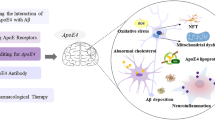Abstract
Many evidence confirms that amyloid beta 1–42 fragment (Aβ1–42) causes neuroinflammation, oxidative stress, and cell death, which are related to progressive memory loss, cognitive impairments and mental disorders that will lead to Alzheimer’s disease (AD) progression. Netrin-1, as a member of the laminins, has been proved to inhibit apoptosis and inflammation outside of nervous system, in addition to having a vital role in morphogenesis and neurogenesis of neural system. This study was designed to assess the protective effects of netrin-1 in SH-SY5Y human neuroblastoma cell line exposed to Aβ1–42 and to explore some mechanisms that underlie netrin-1 effects. Cultured SH-SY5Y neuroblast-like cells were treated with netrin-1 prior to Aβ1–42 exposure and the effects were assessed by MTT and ELISA assay kits. Netrin- 1 pretreatment of Aβ1–42-exposed SH-SY5Y human neuroblastoma cells attenuated Aβ1–42 induced toxic effects, increased cell viability and partially restored levels of 3 inflammatory and oxidative stress biomarkers including: nuclear factor erythroid 2–like 2 (Nrf2), tumor necrosis factor alpha (TNFα) and nuclear factor kappa-light chain-enhancer of activated B cells (NF-κB). Based on the findings of this study, netrin-1 represents a promising therapeutic bio agent to abrogate cellular inflammation and reactive oxygen species (ROS) activation induced by Aβ1–42 in the SH-SY5Y cell model of AD.





Similar content being viewed by others
Data availability
The data that support the findings of this study are available from the corresponding author upon reasonable request.
References
Kumar A, Singh A (2015) A review on Alzheimer’s disease pathophysiology and its management: an update. Pharmacol Rep 67(2):195–203
Winkle CC et al (2014) A novel Netrin-1–sensitive mechanism promotes local SNARE-mediated exocytosis during axon branching. J Cell Biol 205(2):217–232
Swomley AM et al (2014) Abeta, oxidative stress in Alzheimer disease: evidence based on proteomics studies. Biochim Biophys Acta 1842(8):1248–1257
Jing W et al (2009) Arginine vasopressin prevents amyloid beta protein-induced impairment of long-term potentiation in rat hippocampus in vivo. Neurosci Lett 450(3):306–310
Eisele YS et al (2010) Peripherally applied Abeta-containing inoculates induce cerebral beta-amyloidosis. Science 330(6006):980–982
Alzheimer’s Disease International (2019) World Alzheimer Report 2019: Attitudes to dementia, London. Retrieved from https://www.alz.co.uk/research/world-report-2019
Chen J, Chen ZJ (2013) Regulation of NF-κB by ubiquitination. Curr Opin Immunol 25(1):4–12
Lawrence T (2009) The nuclear factor NF-kappaB pathway in inflammation. Cold Spring Harb Perspect Biol 1(6):a001651
Gold R et al (2012) Placebo-controlled phase 3 study of oral BG-12 for relapsing multiple sclerosis. N Engl J Med 367(12):1098–1107
Kovalevich J, Langford D (2013) Considerations for the use of SH-SY5Y neuroblastoma cells in neurobiology. In: Amini S, White MK (eds) Neuronal cell culture: methods and protocols. Humana Press, Totowa, NJ, pp 9–21
Boyer NP, Gupton SL (2018) Revisiting Netrin-1: one who guides (Axons). Front Cell Neurosci 12:221
Lai WS, Correia JP, Kennedy TE (2011) Netrins: versatile extracellular cues with diverse functions. Development 138(11):2153–2169
Petit A et al (2007) Adult spinal cord progenitor cells are repelled by netrin-1 in the embryonic and injured adult spinal cord. Proc Natl Acad Sci USA 104(45):17837–17842
Zamani E et al (2019) Key mechanisms underlying netrin-1 prevention of impaired spatial and object memory in Abeta1-42 CA1-injected rats. Clin Exp Pharmacol Physiol 46(1):86–93
De Strooper B, Karran E (2016) The cellular phase of Alzheimer’s disease. Cell 164(4):603–615
Butterfield DA, Swomley AM, Sultana R (2013) Amyloid beta-peptide (1–42)-induced oxidative stress in Alzheimer disease: importance in disease pathogenesis and progression. Antioxid Redox Signal 19(8):823–835
Amiri M, Braidy N, Aminzadeh M (2018) Protective effects of fibroblast growth factor 21 against Amyloid-Beta1-42-induced toxicity in SH-SY5Y cells. Neurotox Res 34(3):574–583
Amin FU, Shah SA, Kim MO (2017) Vanillic acid attenuates Abeta1-42-induced oxidative stress and cognitive impairment in mice. Sci Rep 7:40753
O’Neill LA, Golenbock D, Bowie AG (2013) The history of Toll-like receptors—redefining innate immunity. Nat Rev Immunol 13(6):453–460
Van Eldik LJ et al (2016) The roles of inflammation and immune mechanisms in Alzheimer’s disease. Alzheimers Dement (N Y) 2(2):99–109
Mulero P et al (2017) Netrin-1 and multiple sclerosis: a new biomarker for neuroinflammation? Eur J Neurol 24(9):1108–1115
Xie Z et al (2018) Recombinant Netrin-1 binding UNC5B receptor attenuates neuroinflammation and brain injury via PPARgamma/NFkappaB signaling pathway after subarachnoid hemorrhage in rats. Brain Behav Immun 69:190–202
Simoni E et al (2017) Targeting the Nrf2/amyloid-beta liaison in Alzheimer’s disease: a rational approach. ACS Chem Neurosci 8(7):1618–1627
Itoh K et al (1997) An Nrf2/small Maf heterodimer mediates the induction of phase II detoxifying enzyme genes through antioxidant response elements. Biochem Biophys Res Commun 236(2):313–322
Ramsey CP et al (2007) Expression of Nrf2 in neurodegenerative diseases. J Neuropathol Exp Neurol 66(1):75–85
Joshi G et al (2015) Increased Alzheimer’s disease-like pathology in the APP/ PS1DeltaE9 mouse model lacking Nrf2 through modulation of autophagy. Neurobiol Aging 36(2):664–679
Acknowledgements
This research has been supported by Electrophysiology Research Center, Neuroscience Institute, Tehran University of Medical Sciences. (Grant No. 33292-139-04-95)
Author information
Authors and Affiliations
Corresponding author
Ethics declarations
Conflict of interest
The authors declare that they have no conflict of interest.
Ethical approval
This study does not require ethical statement.
Additional information
Publisher's Note
Springer Nature remains neutral with regard to jurisdictional claims in published maps and institutional affiliations.
Rights and permissions
About this article
Cite this article
Zamani, E., Parviz, M., Roghani, M. et al. Netrin-1 protects the SH-SY5Y cells against amyloid beta neurotoxicity through NF-κB/Nrf2 dependent mechanism. Mol Biol Rep 47, 9271–9277 (2020). https://doi.org/10.1007/s11033-020-05996-1
Received:
Accepted:
Published:
Issue Date:
DOI: https://doi.org/10.1007/s11033-020-05996-1




